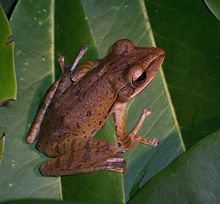 In the Asian Flying Frog amphibian enthusiasts find a rare treat – a fascinating species with rarely-seen reproductive habits that is hardy, inexpensive and fairly easy to breed in captivity. Also known as the Banana Frog, Golden Foam Nest Frog and Asian Treefrog (Polypedates leucomystax, Family Rhacophoridae), this active beauty is well worth more attention from hobbyists and zoos.
In the Asian Flying Frog amphibian enthusiasts find a rare treat – a fascinating species with rarely-seen reproductive habits that is hardy, inexpensive and fairly easy to breed in captivity. Also known as the Banana Frog, Golden Foam Nest Frog and Asian Treefrog (Polypedates leucomystax, Family Rhacophoridae), this active beauty is well worth more attention from hobbyists and zoos.
Description
Females may be up to 3.5 inches in length; males are slightly smaller (please see photo). They have large adhesive toe and finger pads and are variably colored. The background color of brown or tan is often attractively tinged with shades of red, yellow or orange, while some specimens are nearly black. The skin may be spotted, striped or plain in pattern – great fun breeding these fellows, as you never know what to expect in terms of the offspring’s appearances!
Range
Golden Treefrogs are extremely widespread throughout south and Southeast Asia – India, Bangladesh, China, Indonesia, Lao, Malaysia, Myanmar, the Philippines, Taiwan, Thailand, Vietnam; they have been introduced to Japan.
Habitat
Wetlands, forests, farms, parks and large cities, often within houses (“House Frog” is a common local name). Populations often higher in disturbed habitats.
Status in Wild
Golden Treefrogs appear common throughout most of their huge range, and often follow human habitation.
This frog is one of the few amphibian species that seems to benefit from the presence of people – sheltering within buildings in cities and on farms, and feeding upon roaches, flies and other insects to be found there. They often congregate near outdoor lights at night in search of moths, beetles and other insects.
Reproduction
This opportunistic breeder may reproduce year-round or in the wet season, depending upon locality.
Males call from the edges of ephemeral ponds, ditches and similar habitats. Females lay 100-400 eggs in foam nests that are suspended on vegetation over water. The tadpoles hatch in 3-4 days and drop into the water. They are largely predatory, consuming aquatic invertebrates, carrion and each other; some decaying vegetation taken as well. Metamorphosis occurs in 6-7 weeks.
Tadpoles that miss the pond when dropping from their egg masses will actively seek the water’s edge. I’ve experimentally moved water bowls from under hatching eggs and have found that the tadpoles are indeed amazingly mobile on the ground and travel to the water’s edge with surprising speed.
Lowering the terrarium’s temperature to 68F for 2 weeks, followed by a period of heavy misting (or use of a rain chamber) often stimulates reproduction in captivity. Spontaneous breeding also occurs. Pairs invariably position their eggs over water – even if the “pond” is only a small water bowl!
Diet
 The natural diet includes moths, caterpillars, beetles, spiders, ants, roaches, mosquitoes, centipedes, flies and many other invertebrates.
The natural diet includes moths, caterpillars, beetles, spiders, ants, roaches, mosquitoes, centipedes, flies and many other invertebrates.
Captives do not fare well on crickets alone, and should be fed as described in my article on Red-Eyed Treefrogs (please see “Further Reading”). Houseflies, moths, smooth caterpillars, tree crickets and other wild-caught or captive- reared insects are vital to their health.
“Flying” Frogs?
The common name “flying frog” refers to the ability of several related frogs to glide by leaping from tree branches.
This species lacks the adaptations (wide, webbed feet and hands, skin folds along body) possessed by more accomplished gliders, such as Wallace’s Treefrog, Rhacophorus nigropalmatus, and generally accomplishes a “controlled fall”.
Further Reading
Caring For Red-Eyed Treefrogs (feeding tips).
Asian Treefrog Natural History (including photos and recording of calls).
Common treefrog image referenced from wikipedia and originally posted by Wie146
 That Reptile Blog – Reptile, Amphibian and Exotic Pet Care and Information
That Reptile Blog – Reptile, Amphibian and Exotic Pet Care and Information



Thankyou…for info. My Asian Tree frog lived 11 years. The barking….bright golden color…and personality…priceless…what an easy to care for pet!
Hi Davian,
Thanks for the kind words. Very impressive..the published longevity for this species is only 6 years. Unfortunately that system is no longer updated, but you may have a record there; I don;t recall any living that long in our collection at the Bx Zoo. Please let me know what diet/supplements you used, and other care details when time permits – we still have a great deal to learn, and your experience will be very useful to others.
Thx, Best, Frank